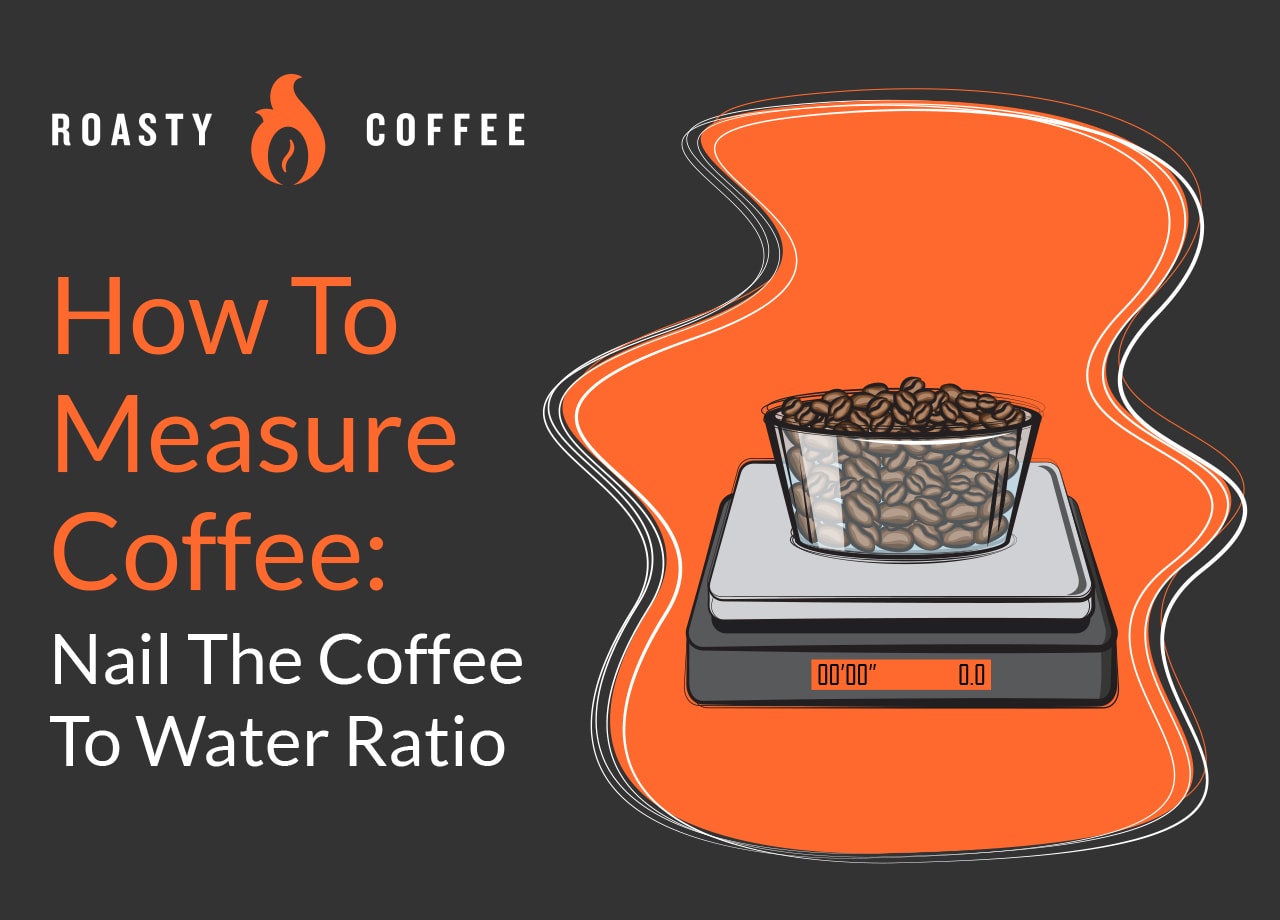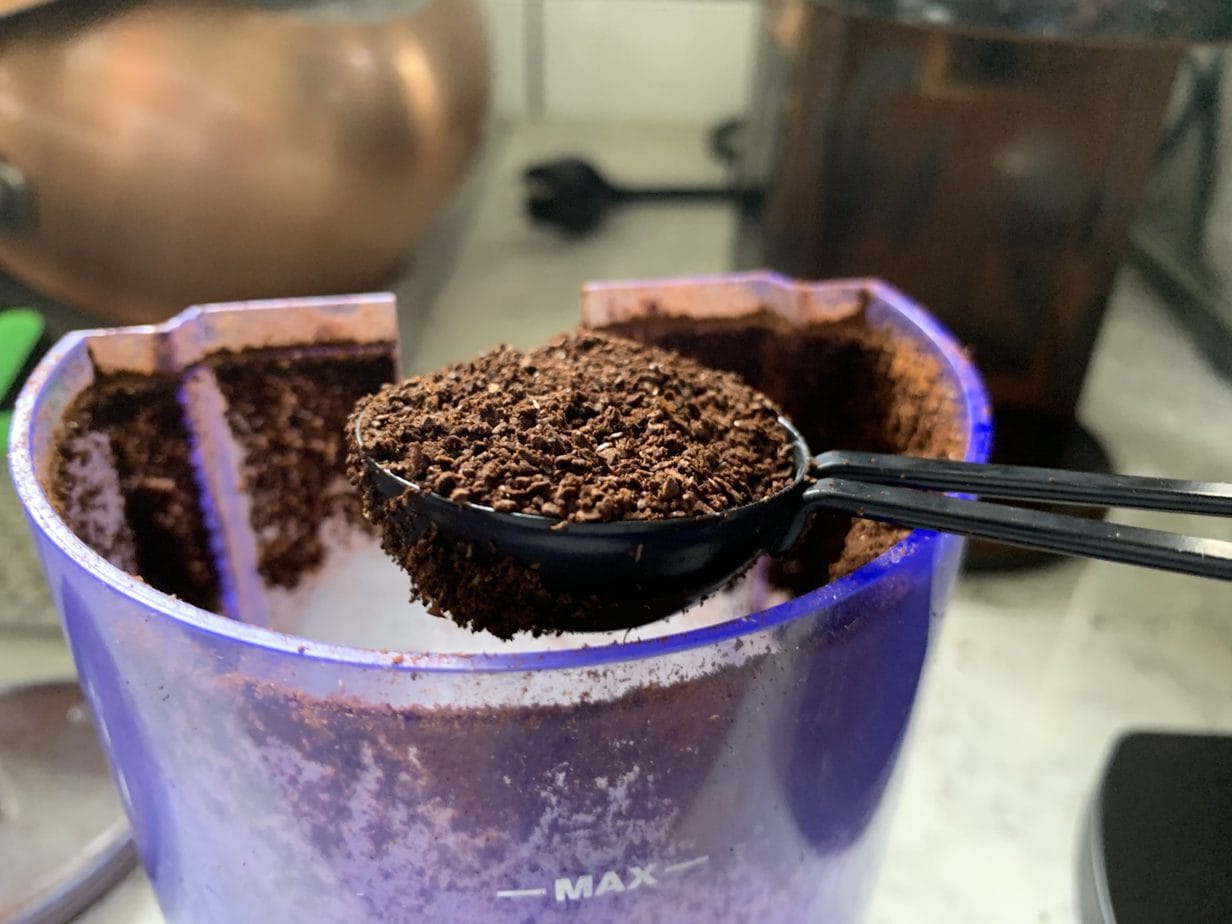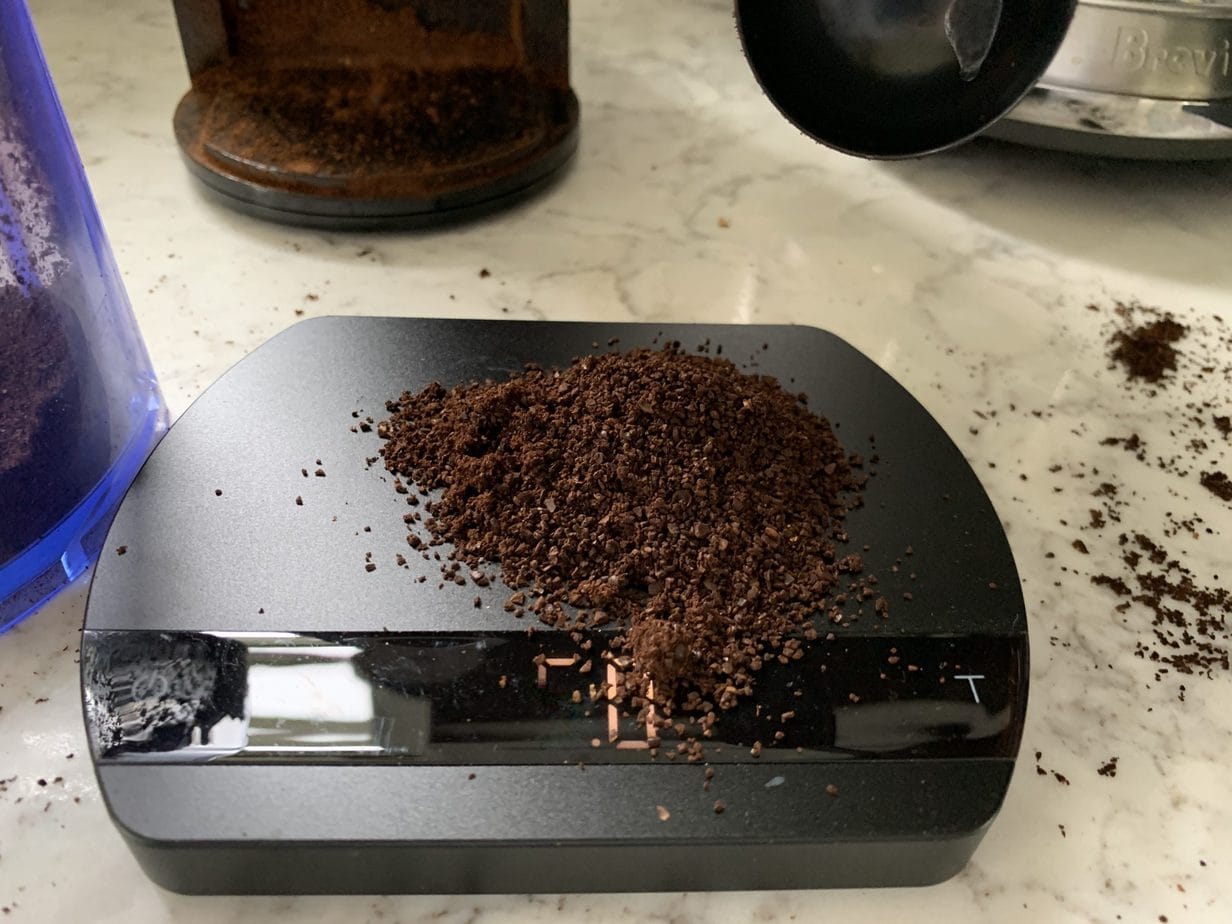How Many Tablespoons For 10 Cups Of Coffee
Just and so you know, if yous click on a product on RoastyCoffee.com and decide to purchase it, nosotros may earn a pocket-size commission.

Does your coffee taste off, but you're non sure why? Chances are you aren't measuring your java properly. Just how exactly do y'all measure out the perfect coffee to water ratio? Stay tuned to find out.
Coffee to Water Ratio Calculator
Before nosotros get into 17:1 ratio vs. 15:ane ratio and how to mensurate coffee for French printing vs. drip java and so much more, hither'southward a quick calculator we created to make the process really simple.
Since most people are using a standard drip coffee maker and aren't neat at java math, we created a tool to help y'all out.
Just let us know how many cups of coffee yous desire to make and what you're measuring with:
bully!
Get-go past filling your java pot up to the line that says "12"
(This is 72 ounces of water)
How are you measuring your java?
ane.5 cups of coffee grounds
+
1.five cups of coffee grounds
12 Cups of coffee
Eliminating Tablespoon Defoliation
As an American, when nosotros starting time talking measurements like milliliters and grams my eyes glaze over.
Just give it to me in good ol' fashioned tablespoons.
The problem is, going from grams to tablespoons in measuring java can exist a little confusing. In fact, when I googled grams to tablespoons I got the answer of "15":

But, when talking about measuring java, that only didn't seem right to me.
And then I grabbed my handy tablespoon and my coffee calibration to come across just how many grams of java you get from a tablespoon.
Here'southward my very scientific experiment:
Commencement, I took what 1 might a phone call a "heaping" tablespoon, not exactly leveled off.

I plopped it downwards on the scale, and it was exactly five.0 grams. (I realized later on that the digital reading didn't show up well on my camera, but I promise it was exactly v.0).

I played around a couple more times and tried to really level off the tablespoon and it dropped to something like iv.3 grams.
Then as you'll see after in this commodity, I'm not smart enough to understand all the different conversion calculators or to say they are "wrong" I merely know in the earth of coffee grounds, a tablespoon of coffee is going to get you most 5 grams of coffee.
That'due south why y'all'll encounter in our nautical chart below and our reckoner above, we say 10.6 grams of coffee is about ii tablespoons.
Why Measuring Matters
In order to make a consistent cup of coffee each and every time, information technology'south important to develop the habit of accurate measurement. To do that, there'southward no substitute for a minor kitchen calibration that measures in grams. With information technology, you can mensurate h2o, beans, and grounds.
Our preferred ratio of water to coffee beans is 500 grams (or milliliters) of water to 30 grams of whole coffee beans. Feel free to experiment, but this produces the closest thing to a universally adequate coffee force.
What You'll Need
- Digital kitchen scale
- Water
- Coffee
How Information technology'southward Done
*Nosotros are going to exist brewing with a roughly i:17 coffee to water ratio to brew about 2 cups of java using the charts beneath. If you don't have a scale yet, use the volume measurements to get past.
Measure the h2o
Put your empty, cool kettle on the calibration and striking the tare push. This resets the scale to zero so that y'all'll only measure out what you put inthe kettle.
Then, slowly add water to the kettle until it reaches 355 grams. Once you lot hit the mark, set the kettle aside.
Tip: If you're planning on boiling h2o, you can add a little more to compensate for water evaporation.
Measure the Beans
Reset your calibration and detect a clean bowl or container to place on top for your grounds. Hit the tare push to set things dorsum to nothing.
Next, either scoop beans into your container until yous reach 21 grams. If y'all are using whole beans and grinding them fresh, yous can measure weight with the whole beans earlier grinding them.
Brew Fourth dimension!
Now that y'all have the perfect amount of water and coffee, information technology's time to commencement brewing. Add your grounds to your drip brewer's filter and pour the water into the reservoir.
Adjusting the Servings
That wasn't then bad, right? The part that intimidates virtually people is determining how much coffee and water to employ based off of their desired servings.
Because of this, brewing without an automated drip can be daunting. Particularly for those of us less mathematically inclined, nailing the coffee to water ratio can exist deceptively troublesome. However, there's no need for guesswork and mediocre coffee any more than.
For reference, you lot can check out this great nautical chart as a starting point, and accommodate the ratios to your liking as you brew on into the future. This one roughly follows the i:17 rule, but you tin increase or decrease how much grounds yous employ for brewing to reach higher or lower intensities.
Still, you shouldnot,decrease or increase the water component equally you adjust. Stick to the advisable corporeality of h2o for your mash size and change the amount of coffee you lot are using instead. That manner, you aren't really affecting howmuchjava is brewed, merely how information technology tastes.
Coffee Brewing Ratio Chart

Mixing it Upwardly
These guidelines are all fine and dandy, simply what if yous want a stronger or weaker brew?
Need More than Power!
With drip brewers, adding actress grounds to adjust your coffee to water ratio works to strengthen your brew to an extent. i:15 to 1:eighteen is considered the "golden ratio;" however, we used about a one:17 ratio because it falls around a nice mid level of intensity. We wouldn't actually recommend going past 1:xv though considering there really can exist also much of a practiced thing.
If y'all add also many grounds for the amount of water you're using, your coffee will feel dirty or heavy. Also, it probably won't taste much stronger than a more appropriate corporeality would. And then save your grounds and you coin and don't overdo it.
For those of you lot who take reached at upper limit, it may be time to invest in a darker roast or a different brewing tool altogether. Drip brewers tin can only exercise and so much, and if y'all're peckish a direct shot of espresso, they just aren't going to cut it.
Trying to Avoid Centre Palpitations…
On the other cease of things, you lot can become up to a 1:18 and peradventure slightly past that, though not much. This volition make a lighter, weaker java that is ameliorate enjoyed with minimal additions.
Like with strengthening your mash at the lower end of the ratio spectrum, having also lilliputian grounds can also have bug. Not simply will your coffee taste weak, it may also exist overextracted. If that is the case, your java will taste incredibly bitter. No one wants that!
Other Brewing Methods
With Third Wave of coffee brewing in full force, there's a good chance you're brewing with something other than an automatic drip brewer. So below, we take a handy interruption down of how y'all should be measuring your coffee for each of the most popular brewing methods.
Go on in listen though that these are mostly merely rules of thumb. Every bit nosotros mentioned before, changing up the coffee to h2o ratio is as well how you change the force of your mash. So think of these recommendations as a identify to first your experimentation until y'all country on the combination that'southward best for you lot!
Pro Tip:You lot can utilize the water corporeality per serving guidelines above for these other brewing methods as well. Just change upwardly how much coffee yous're using.
Cold Brew
Let'southward starting time with cold brew, the perfectly refreshing, laid-back summer drink. Keep in mind that this blazon of brewing creates a concentrate, rather than a finished brew. So later on downwards the line it volition be diluted with more water, so don't start having heart palpitations over our suggested ratios.
If you're new to the brew, try starting with a 1:8 coffee to water ratio. This should give you a dainty, mid-level forcefulness intensity that'due south suitable for almost. For those of you who already know y'all're going to want something stronger, endeavor starting at i:v.
Moving on to how to dilute information technology, this phase is every bit dependent on your tastes, and so remember to mix it up for each loving cup throughout your first batch. You lot should dilute the coffee concentrate as you lot drink it rather than in the carafe all at once.
Yous should kickoff with a 1:2 ratio of coffee to dilutor with ice. If you aren't an water ice fan, only add together a bit more than water. Gustatory modality the brew and go from in that location, tweaking the dilution or brew ratio equally needed.
Cascade Over
Pour Over coffee is a chip more of an artful and exact science. And so while yous can probably get away with going scaleless for drip or common cold brews, you'll definitely need it for this method. If you've brewed Cascade Over java before, you lot know how much of a deviation having a gooseneck kettle makes. Using a scale to measure is as, if non more, important.
A proficient place to beginning your pour over journeying is with a ane:17 coffee to water ratio. However, if you haven't however been able to get your hands on a scale, y'all can utilise one-2 tablespoons of coffee for every vi ounces of water. This method won't get yous the exact same results every time, but it should be able to get the chore done anyway.
French Printing
At present back to some other more forgiving brewer, the French Press. For those of you who are looking to achieve a stronger, bolder brew with thick, heavy flavors, showtime with a 1:ten ratio. People who prefer something a bit lighter or more tea-like, then start with 1:16.
Apply those ii ends equally guidelines and adjust to fall somewhere in betwixt as you wish. For those of yous whohoweverhaven't invested in a scale (seriously, you demand to). Commencement with a ii tbsp to 6 ounces of water ratio and move up or downwardly from there.
All the same, because you need a coarse grind with French printing brewing, there'south a lot of infinite between grounds. So weight is going to be much more accurate than using another measuring method.
AeroPress
Next upward nosotros have a squad favorite, the Aeropress. This is a rather unique brewing tool. Past irresolute your ratios upward, yous can accomplish annihilation from an espresso-like concentration to something resembling your average mash.
Yet, unlike with the other brews, this tool actually comes with a measuring system with it. The Aeropress itself has oval markers on it labelled 1, ii, 3, and 4. It also comes with a scoop, the numbers correspond to how many scoops/servings yous're using/making, and the label position act every bit guides for calculation water.
The brand recommends filling the printing even to the 1 or iv numbers if yous use ane or 4 scoops. If you lot are using ii or 3 scoops, you can either fill to the bottom or tops of the ovals. Filling to the lesser will create a richer brew for something similar a Latte and the tops will weaken the brew a scrap to be more than appropriate for an Americano or Long Blackness.
Whole Beans vs Ground Java
Buying whole bean java and grinding it yourself is a great way to ensure your coffee is fresh. However, does this touch on how you're measuring your coffee?
Well, if yous are using a scale, not really at all. Grinders, especially hand grinders, are typically built to be low static, so your grounds shouldn't be getting stuck much if at all. Thus, the weight of your grounds should be essentially the aforementioned in one case they're ground as they were whole.
On the other hand, if you are simply using volume measurement tools, information technology can be a petty difficult to determine how much coffee to grind. But we have a rule of thumb to help you out.
Each tablespoon holds almost 5 grams of java, and a mL of water weights almost a gram. From in that location, yous merely need to practise some unproblematic math using your called ratio.
Keep in mind though, that while this guesstimating may work for some brewers, it leaves a bit besides much room for mistake with others.
Oft Asked Questions
Why do you demand a calibration to measure out java?
For about of the brew methods to a higher place, a scale does have a significant touch on on the consistency and quality of your coffee. However, the level of necessity does vary between methods.
For Pour Overs and other drip-based brewers, it is absolutely necessary to have a calibration. On the other hand, it's benign just not vital for immersion brews like French Printing and Common cold Brew. It'southward prissy if you desire to step up your brew game, but you lot tin get away without one.
Lastly, if yous have an Aeropress, their tool is specifically designed for you to use their measuring tools. And so while yous certainly could use a calibration to do some experimentation, using their guide volition do just fine.
How do you measure java without a calibration?
As you probably noticed on the chart we included higher up, in that location are multiple ways to measure how much coffee or water you need for a brew. If you tin can't invest in a calibration or are simply using a brew method that exactness is less of import, using your usual measuring tools will work fine.
Things similar automatic drip brewers or the clever coffee dripper are designed to give you a little wiggle room on your java to water ratio. So if your weights are slightly off because y'all measured with tablespoons and cups rather than a scale, your coffee will all the same taste fine.
Notwithstanding, we practice not recommend doing this with something like a Pour Over because slight variances can completely change the consequence of your brew.
Does grind size also bear upon coffee forcefulness?
Aye, to an extent. With measurements and ratios, you have a good chip of wiggle room to find what works best for you personally. However, you lot tin can somewhat affect the strength of your brew by switching upward how coarse or fine you are grinding your beans.
At present, this is simply actually applicable if yous are grinding your own beans (which you should be) and have a grinder with a considerable range of sizes. For example, you lot can employ a slightly finer grind (like a medium or medium-fibroid) from your usual coarse grind, the result will be a slightly stronger mash.
A like principle applies to the other brew, effectively grinds will be a bit stronger and coarser ones volition be weaker. However, this doesn't work the aforementioned way every bit as adjusting the h2o to coffee ratio. You lot can adjust those measurements as much as you please for the nearly part.
But, if you use a grind that is besides coarse or fine for the brewer you're using your coffee will exist over or nether-extracted. Furthermore, if you employ a grind that'south way dissimilar than what what's advisable for your brewer, you lot could end up bottleneck or damaging it.
Wrapping Up
Different methods and preferences will call for different measurements. Your journey down the Path of the Bean will yield a multifariousness of approaches, so feel free to experiment. In the cease, only y'all can decide what's all-time for your loving cup.
Relish!
Share the goods

Make every mean solar day succulent
Sign up for a free newsletter to help you lot mash amazing coffee at domicile.

Mash like a Barista
from home
The Home Barista Coffee Course 14-lesson video form about brewing consistently amazing java at dwelling. Stream or download the entire course to learn how to make coffee as good as your local barista for a fraction of the price.
Learn more than
How Many Tablespoons For 10 Cups Of Coffee,
Source: https://www.roastycoffee.com/measure-coffee/
Posted by: mitchellgoolifter.blogspot.com


Belum ada Komentar untuk "How Many Tablespoons For 10 Cups Of Coffee"
Posting Komentar